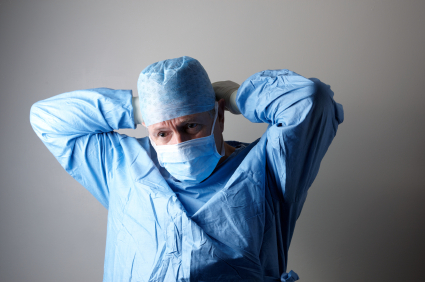Hospital dress code could be a test case for tracking infections


Someone needs to take a bag of swabs and a stack of petri dishes to The Ottawa Hospital.
We might finally have the perfect environment to test whether hospital attire has any bearing on infection rates inside and outside of hospitals with superbugs such as MRSA and Clostridium difficile. The trick will be convincing the hospital of that.
According to Samia Madwar at the Canadian Medical Association Journal, The Ottawa Hospital has declared that "the code requires staff to don their scrubs and lab coats whenever they enter the hospital, and take them off when they leave, even for a quick trip to the convenience store."
In announcing the new policy, the hospital wrote that, "This strengthens the quality of patients' interactions with staff, improves infection control, and ensures TOH will continue to portray a professional image."
As Madwar writes:
Such safety concerns appear justified in the wake of studies that have demonstrated that hospital attire may place patients at risk of infections. Over the past decade, research has shown that C. difficile and Methicillin-resistant Staphylococcus aureus (MRSA), two common culprits behind hospital-acquired infections, may be transmitted to patients via lab coats and nurses' uniforms. The evidence, though not conclusive, helped lead to measures in the United Kingdom that eliminate dangling bits of clothing, such as neckties, as well as jewelry (J Hosp Infect 2007;4:301–07).
This news should be of great interest to regular readers of Antidote, who helped spark a national conversation this spring about whether people should confront hospital workers seen wearing scrubs outside medical settings.
Dr. David C. Martin, a retired Sacramento anesthesiologist, argued that people would be making a stand for public health if they simply walked up to medical staff seen in restaurants and other public places wearing scrubs and asked them to change. Martin wrote:
I believe, as does the medical community at large, that it is time for all of us to take responsibility for our health and safety, rather than displacing the entirety of this onus to our caregivers. Purging public spaces of hospital-exposed garments could make more than a public fashion statement. It could reduce illness and even death from infectious disease.
Antidote contacted The Ottawa Hospital, and it kindly sent along the hospital's Personal Protective Garment Policy, which states:
Hospital provided garments are laundered by the Hospital and may only be worn on Hospital premises. Employees observed leaving the premises wearing protective garments would be subject to inspection by Security personnel. The employees will be required to return the garments immediately and Security personnel will file an incident report with the affected individuals' supervisor for appropriate actions.
Antidote asked the hospital whether it has done any research into the infection-control implications of its new policy or whether it intends to investigate those implications. Communications Advisor Hazel Harding told me that the policy was more about professionalism than infection control. She wrote that the hospital had done no research around the infection control implications.
Perhaps we'll have to wait for another hospital to step up to truly research whether scrubs and sandwiches should mix.
Related Posts:
Hospital scrubs and sandwiches should not mix
Superbugs may show up wearing hospital scrubs
Hospital scrub scrapping, and patient safety, can start with one tough conversation
Doctors sound off - loudly - about wearing scrubs on the street
Hospitals must change surgical scrub culture from within
Ban on mixing hospital scrubs and sandwiches gains currency

